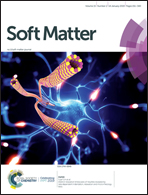Illustration and application of enhancing effect of arginine on interactions between nano-clays: self-healing hydrogels†
Abstract
Nano-clays (NCs) as a representative type of nano-materials are a source of inspiration for design of new biomedical materials with excellent performances. Research has shown that guanidinium ions (Gu+) can form non-covalent salt-bridge interactions with NCs, serving as “molecular glue” in the fabrication of NC-based composites. However, synthesis of the Gu+-containing molecules is always not easy. Since the natural amino acid arginine (Arg) possesses Gu+, Arg could potentially be a replacement for the synthetic molecules. To prove this possibility, nano-composites were constructed by combining model anisotropic NCs with Arg-modified nano-hydroxyapatite (nHAP-Arg) and polyarginine (poly-Arg), respectively. Formation of molecular interactions between NCs and nHAP-Arg/poly-Arg was demonstrated by enhanced gelation behaviour of NCs. Through taking the unique advantage of Arg, this study can be readily implemented in constructing a variety of NC-based composites with diverse functionalities that are necessary for potential applications in tissue engineering and regenerative medicine.



 Please wait while we load your content...
Please wait while we load your content...